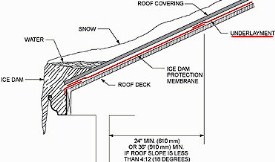I do not set out purposefully to learn something new every day, it just seems to happen.
Today, Rachel, the most senior Building Designer at Hansen Buildings asked me if I had ever heard of a slip sheet. When I inquired of her further, she advised she was looking at a set of plans for a commercial pole building. The Registered Design Professional (RDP) had indicated on the drawings a “slip sheet”, with no explanation in the specifications as to what it was.
This particular post frame building is designed for concealed fastener steel roofing to be applied over 5/8” cdx plywood roof sheathing. 30# asphalt impregnated paper (roofing felt) is to be laid over the plywood. The whole purpose of the felt paper is to help keep leaks out of the attic. All of the above is fairly standard installation procedure for roofs of this type.
So, it was then time for me to hit the search engine trail.
 I found the National Roofing Contractors Association (NRCA) recommends a slip sheet be installed over the underlayment (felt paper or similar) for metal panel roof systems. A slip sheet is a layer of smooth building paper, such as rosin-sized or unsaturated building paper. Its purpose is to protect the underlayment from damage, as the steel panels can adhere to and tear the underlayment.
I found the National Roofing Contractors Association (NRCA) recommends a slip sheet be installed over the underlayment (felt paper or similar) for metal panel roof systems. A slip sheet is a layer of smooth building paper, such as rosin-sized or unsaturated building paper. Its purpose is to protect the underlayment from damage, as the steel panels can adhere to and tear the underlayment.
There is also another option for metal roofing underlayment. New polymer underlayments sheets are thinner and easier to work with than layers of tar paper and rosin paper. The sheets are strong, waterproof and slick, so they can replace both of the other underlayment layers.
Fire resistant slip-sheets are also available. They enhance the overall fire protection of many commercial roof systems, including steel roofs. Usually they are a coated-glass fiber mat, specifically designed for installation over wood decks (like cdx plywood) or certain combustible insulation (like expanded polystyrene).
The flame-retardant coating and glass-fiber mat provide protection against flame spread and flame penetration through the roof system. The slip-sheet can also act as a barrier between chemically incompatible insulation and roof membranes. In addition, the sheet may be used in multiple layers to achieve certain Class A fire resistance ratings.
It would be my recommendation to use a slip sheet with a concealed fastener steel roofing system which relies upon “clips” to attach the steel to the structure below. In this type of system, the steel roofing is left to “float” and the movement back and forth on the clips could cause tears in felt paper only underlayments. It would be unusual for either traditional through screwed steel roofing, or concealed fastener panels which are screwed down to the roof deck to have enough movement to make a slip sheet necessary.







Is it ok then to screw a standard metal roof panel directly to the asphalt shingles? No underlayment, No 2×4 grid or framework, just metal panels laying direclty on the asphalt shingles and screwed tightly in place.? I am about to put a metal roof over a hunting cabin deep in the woods (codes not an issue) and it has asphalt shingles with some 6 or 8 small leaks that need to be fixed. Any advice you can give me will be greatly appreciated. oh2
In a word – NO. The steel panels will quickly become a deer blind somewhere off in the nearby woods. In order for those screws to be tight, they need to screw into something solid. 2x4s placed flat on top of the shingles and nailed securely to the rafters which support the sheathing below are inexpensive and provide a good solid resting place for the ends of the screws.
Your explanation that metal roofing needs to have a slip sheet underneath to help the metal adhere to the roof is very thorough. It’s interesting that these sheets also protect the underlayment from tears and keep the attic sealed. With this information on how protected my roof will be with sheet metal roofing, maybe I should start looking into a roofer to install it.
Always good to have positive feedback from others in the industry. As your website shows you are a steel roofing installer, I would think you should be more than capable of doing your own work without having to find a roofer.